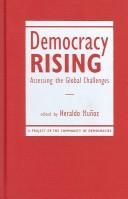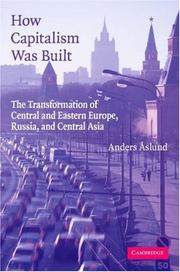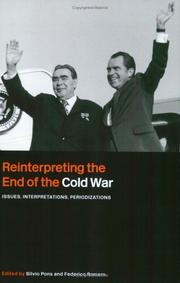| Listing 1 - 10 of 12 | << page >> |
Sort by
|
Book
ISBN: 9781107651135 9781107035539 9781139565028 Year: 2013 Publisher: Cambridge Cambridge University Press
Abstract | Keywords | Export | Availability | Bookmark
 Loading...
Loading...Choose an application
- Reference Manager
- EndNote
- RefWorks (Direct export to RefWorks)

ISBN: 1588264289 158826405X 1685857841 Year: 2006 Publisher: Boulder Lynne Rienner
Abstract | Keywords | Export | Availability | Bookmark
 Loading...
Loading...Choose an application
- Reference Manager
- EndNote
- RefWorks (Direct export to RefWorks)
This timely assessment of both the progress toward democratic governance globally and the significant challenges that democracies face is the outcome of a seminar organized by the Community of Democracies. The Community is a group of more than a hundred countries devoted to the spread and consolidation of democracy around the world.
841.1 Democratisering --- Comparative government --- Democracy --- World politics --- Former communist countries --- Politics and government.
Book
ISBN: 9781032156347 Year: 2022 Publisher: New York, NY : Routledge, 2022.
Abstract | Keywords | Export | Availability | Bookmark
 Loading...
Loading...Choose an application
- Reference Manager
- EndNote
- RefWorks (Direct export to RefWorks)
This book examines contemporary militant democracies in post-communist states in the European Union. Examining, through case studies, their broader relevance to political, legal, and social structures, this book looks in revealing detail at the struggles between these democratic and anti-democratic actors that share similar historical experiences of contentious politics, communism, and political transformation. It importantly unravels the tension between them, determining which are already authoritarian, and which are teetering on the brink of an anti-democratic breakthrough. Analyzing regimes' continuance trajectories to capture how and what shaped the neo-militant aspects of democracies (neo-militancy) over time, the book accounts for why particular post-communist European neo-militant democracies emerge while others decline or transform into quasi-militant democracies despite transformation, how they differ from each other, what brings the differences and similarities between them, and how and why they change over time. With right-wing populist parties coming to power on the back of fears associated with economic, social, and cultural globalization and the misuse of state authorities to strengthen protective measures against threats to democratic institutions, the book represents a timely and important contribution.
Book
ISBN: 9780415639576 0415639573 Year: 2013 Publisher: London: Routledge,
Abstract | Keywords | Export | Availability | Bookmark
 Loading...
Loading...Choose an application
- Reference Manager
- EndNote
- RefWorks (Direct export to RefWorks)
Between 2000 and 2005, colour revolutions swept away authoritarian and semi-authoritarian regimes in Serbia, Georgia, Kyrgyzstan and Ukraine. Yet, after these initial successes, attempts to replicate the strategies failed to produce regime change elsewhere in the region. The book argues that students of democratization and democracy promotion should study not only the successful colour revolutions, but also the colour revolution prevention strategies adopted by authoritarian elites. Based on a series of qualitative, country-focused studies the book explores the whole spectrum of anti-democratization policies, adopted by autocratic rulers and demonstrates that authoritarian regimes studied democracy promotion techniques, used in various colour revolutions, and focused their prevention strategies on combatting these techniques. The book proposes a new typology of authoritarian reactions to the challenge of democratization and argues that the specific mix of policies and rhetoric, adopted by each authoritarian regime, depended on the perceived intensity of threat to regime survival and the regime’s perceived strength vis-à-vis the democratic opposition.
Authoritarianism --- Democracy --- Race relations --- Regime change --- Coups d'état --- Protest movements --- Opposition (Political science) --- Revolutions --- Former Soviet republics --- Politics and government --- RevolutionsFormer Soviet republicsPolitics and government --- Authoritarianism - Former communist countries --- Democracy - Former communist countries --- Race relations - Former communist countries --- Regime change - Former communist countries --- Coups d'état - Former communist countries --- Protest movements - Former Soviet republics --- Opposition (Political science) - Former Soviet republics --- Revolutions - Former Soviet republics --- Former Soviet republics - Politics and government
Book
ISBN: 9780415439596 0415439590 Year: 2007 Publisher: London : Routledge,
Abstract | Keywords | Export | Availability | Bookmark
 Loading...
Loading...Choose an application
- Reference Manager
- EndNote
- RefWorks (Direct export to RefWorks)
Book
ISBN: 9780415571692 0415571693 Year: 2010 Publisher: London: Routledge,
Abstract | Keywords | Export | Availability | Bookmark
 Loading...
Loading...Choose an application
- Reference Manager
- EndNote
- RefWorks (Direct export to RefWorks)
The communist world was supposed to have had its 'revolution' in 1989. But the demise of the Soviet Union came two years later, at the end of 1991; and then, perplexingly, a series of irregular executive changes began to take place the following decade in countries that were already postcommunist. The focus in this collection is the changes that took place in Serbia, Georgia, Ukraine and Kyrgyzstan between 2000 and 2005 that have together been called the 'coloured revolutions': of no particular colour in Serbia, but Rose in Georgia, Orange in Ukraine and Tulip in Kyrgyzstan. Apart from exploring political change in the 'coloured revolution' countries themselves, the contributors to this collection focus on countries that did not experience this kind of irregular executive change but which might otherwise be comparable (Belarus and Kazakhstan among them), and on reactions to 'democracy promotion' in Russia and China. Throughout, an effort is made to avoid taking the 'coloured revolutions' at face value, however they may have been presented by local leaders and foreign governments with their own agendas; and to place them within the wider literature of comparative politics. This book was previously published as a special issue of "Journal of Communist Studies and Transition Politics".
Regime change --- Coups d'état --- Protest movements --- Opposition (Political science) --- Revolutions --- Democracy --- History --- Former Soviet republics --- Politics and government --- DemocracyHistory --- HistoryFormer Soviet republics --- Former Soviet republicsPolitics and government --- Regime change - Former communist countries --- Coups d'état - Former communist countries --- Protest movements - Former Soviet republics --- Opposition (Political science) - Former Soviet republics --- Revolutions - Former Soviet republics - History --- Democracy - Former Soviet republics - History - 21st century --- Former Soviet republics - Politics and government --- Former Soviet republics - History - 21st century --- Former Soviet republics - Politics and government - 21st century
Book
ISBN: 9780521133081 9780521115988 9780511804939 0521115981 0521133084 9780511658631 051165863X 9780511656774 0511656777 0511804938 1107203147 9781107203143 0511700644 9780511700644 0511655924 9780511655920 0511657323 9780511657320 Year: 2010 Publisher: Cambridge New York Cambridge University Press
Abstract | Keywords | Export | Availability | Bookmark
 Loading...
Loading...Choose an application
- Reference Manager
- EndNote
- RefWorks (Direct export to RefWorks)
Democracy and Authoritarianism in the Postcommunist World examines three waves of democratic change that took place in eleven different former Communist nations. It draws important conclusions about the rise, development, and breakdown of both democracy and dictatorship in each country, providing a comparative perspective on the post-Communist world. The first democratic wave to sweep this region encompasses the rapid rise of democratic regimes from 1989 to 1992 from the ashes of Communism and Communist states. The second wave arose with accession to the European Union (from 2004 to 2007) and the third, with the electoral defeat of dictators (1996 to 2005) in Croatia, Serbia, Georgia, and Ukraine. The authors of each chapter in this volume examine both internal and external dimensions of both democratic success and failure.
#SBIB:324H71 --- #SBIB:328H27 --- #SBIB:328H262 --- Politieke verandering: modernisatie, democratisering, regional development --- Instellingen en beleid: Midden- en Centraal Europa: algemeen --- Instellingen en beleid: Rusland en het GOS --- #SBIB:328H262Politieke verandering: modernisatie, democratisering, regional development --- Authoritarianism --- Democracy --- Self-government --- Political science --- Equality --- Representative government and representation --- Republics --- Authority --- Former communist countries --- Former Soviet bloc --- Second world (Former communist countries) --- Communist countries --- Politics and government. --- Social Sciences --- Political Science
Book
ISBN: 9780415689687 0415689686 Year: 2012 Publisher: London: Routledge,
Abstract | Keywords | Export | Availability | Bookmark
 Loading...
Loading...Choose an application
- Reference Manager
- EndNote
- RefWorks (Direct export to RefWorks)
This book reviews the interplay between domestic contexts and democracy promotion efforts in selected countries of the former Soviet Union and the Western Balkans. The idea behind the six case studies is twofold. In the three cases where 'colour revolutions' occurred (Serbia, Georgia, Ukraine), the authors explore the extent to which external democracy promoters adapted their strategies to respond to new domestic contexts. In the other three cases (Azerbaijan, Belarus, Russia) the authors investigate how the political leadership has reacted to 'colour revolutions' elsewhere and which consequences their reactions have had for democracy promotion. In all cases an assessment of democratization processes in the country is provided as a basis for drawing conclusions about the potential for domestic and foreign actors to promote democratic development. An introduction and conclusion embed the case studies in the existing literature on democracy promotion and generalize the findings across the countries studied. On the practical level, the volume offers suggestions for improving democracy promotion endeavours, proposing in particular a more balanced approach which goes beyond supporting specific individuals and organizations to include addressing the structural level. This book was published as a special issue of Democratization.
Protest movements --- Opposition (Political science) --- Regime change --- Coups d'état --- Democratization --- Former Soviet republics --- Politics and government --- New democracies --- #SBIB:328H27 --- #SBIB:324H70 --- Countries, Newly democratic --- Democracies, New --- Democratic states, New --- Emerging democracies --- Nations, Newly democratic --- New democratic states --- Newly democratic states --- States, Newly democratic --- Democracy --- Newly independent states --- Democratic consolidation --- Democratic transition --- Political science --- Instellingen en beleid: Midden- en Centraal Europa: algemeen --- Politieke verandering: algemeen --- CIS countries --- Commonwealth of Independent States countries --- Ex-Soviet republics --- Ex-Soviet states --- Former Soviet states --- New Independent States (Former Soviet republics) --- Newly Independent States (Former Soviet republics) --- NIS (Former Soviet republics) --- New democraciesInstellingen en beleid: Midden- en Centraal Europa: algemeen --- Politieke verandering: algemeenFormer Soviet republics --- NIS (Former Soviet republics)Politics and government --- Protest movements - Former Soviet republics --- Opposition (Political science) - Former Soviet republics --- Regime change - Former communist countries --- Coups d'état - Former communist countries --- Democratization - Former communist countries --- Former Soviet republics - Politics and government

ISBN: 9780521683821 9780521865265 9780511790416 0511790414 9780511342653 0511342659 9780511339899 0511339895 9780511341014 0511341016 0521683823 0521865263 1107178649 9786611085230 0511342128 0511341598 0511573316 1281085235 9781107178649 9781281085238 6611085238 9780511342127 9780511341595 9780511573316 Year: 2007 Publisher: Cambridge New York, NY Cambridge University Press
Abstract | Keywords | Export | Availability | Bookmark
 Loading...
Loading...Choose an application
- Reference Manager
- EndNote
- RefWorks (Direct export to RefWorks)
Anders Åslund foresaw the collapse of the Soviet Union in his book Gorbachev's Struggle for Economic Reform (1989). He depicted the success of Russia's market transformation in How Russia Became a Market Economy (1995). After Russia's financial crisis of 1998, Åslund insisted that Russia had no choice but to adjust to the world market (Building Capitalism, 2001), though most observers declared the market economic experiment a failure. Why did Russia not choose Chinese gradual reforms? Why are the former Soviet countries growing much faster than the Central European economies? How did the oligarchs arise? Who is in charge now? These are just some of the questions answered in How Capitalism Was Built, covering twenty-one former communist countries from 1989 to 2006. Anybody who wants to understand the confusing dramas unfolding in the region and to obtain an early insight into the future will find this book useful and intellectually stimulating.
330.342.14 --- 330.342.15 --- Post-communism --- -Privatization --- -330.947 --- Denationalization --- Privatisation --- Contracting out --- Corporatization --- Government ownership --- Postcommunism --- World politics --- Communism --- Kapitalistische economie. Free enterprise. Markteconomie. Vrije concurrentie --- Centraal geleide economie. Socialistische economie. Communistische economie --- Former communist countries --- -Former communist countries --- -Former Soviet bloc --- Second world (Former communist countries) --- Communist countries --- Economic conditions --- Economic policy --- Privatization --- Economic policy. --- CommunismKapitalistische economie. Free enterprise. Markteconomie. Vrije concurrentie --- Centraal geleide economie. Socialistische economie. Communistische economieFormer communist countries --- Communist countriesEconomic conditions --- Economic conditions. --- -Economic conditions --- 330.342.15 Centraal geleide economie. Socialistische economie. Communistische economie --- 330.342.14 Kapitalistische economie. Free enterprise. Markteconomie. Vrije concurrentie --- Central Asia --- 330.947 --- Former Soviet bloc --- Economic order --- Russia --- Eastern and Central Europe --- Business, Economy and Management --- Economics --- Anciens pays communistes --- POST-COMMUNISME --- anciens pays communistes --- situation économique --- situation sociale

ISBN: 0714684929 071465695X 0714656003 Year: 2005 Volume: 6 Publisher: London Cass
Abstract | Keywords | Export | Availability | Bookmark
 Loading...
Loading...Choose an application
- Reference Manager
- EndNote
- RefWorks (Direct export to RefWorks)
The history of the Cold War is being re-written according to the newly available sources. But first and foremost it needs to be re-conceptualized and framed within the broader historical context that transformed the Cold War from the 1960s onwards, altered the very dynamics of bipolarism, and eventually brought it to its end. The long duration and the unexpectedly peaceful ending of the Cold War call for new views that transcend the established paradigms about its inception. Historians ought to address all those transformations in the international economy, in the networks of interdependence linking together new areas - especially in Asia - and in the ensuing cultural images that gradually narrowed the relevance of bipolarism. Thus the habitual diplomatic and security themes must be enjoined with economic, ideological, technological and cultural ones. Here a distinguished group of international history specialists discusses the complex relationship between Cold War dynamics, the globalizing of capitalism, and the demise of Soviet Communism. Their controversial and conflicting views, as well as their multidisciplinary approaches, highlight the various factors that constituted (and did not constitute) the Cold War. Thus they help to redefine the concept itself, to map its values and limitations, and to propel historical debate onto new grounds.
World history --- anno 1900-1999 --- Cold War --- Guerre froide --- Congresses --- Congrès --- Communist countries --- Pays socialistes --- History --- Congresses. --- Histoire --- World politics --- #A0505HI --- -Iron curtain lands --- Russian satellites --- Second world (Communist countries) --- Soviet bloc --- Former communist countries --- World politics#A0505HICommunist countries --- Former communist countriesHistory --- -History --- Congrès --- Iron curtain lands
| Listing 1 - 10 of 12 | << page >> |
Sort by
|

 Search
Search Feedback
Feedback About UniCat
About UniCat  Help
Help News
News